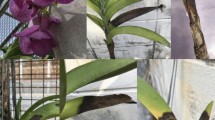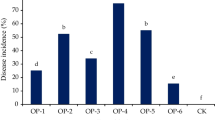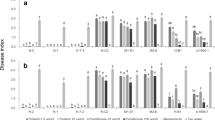Abstract
Brown rot (Phomopsis vexans) is a destructive disease of eggplant, which mainly causes fruit rot. It is currently managed through extensive foliar applications of fungicides, such as benzimidazole chemicals. In this research study, a total of 513 single-conidial isolates of P. vexans were collected between 2010 and 2013 for the purpose of characterizing their resistance to benzimidazole fungicides and diethofencarb. Two types of benzimidazole-resistant (Ben R) isolates, Ben R1 (benzimidazole-resistant and diethofencarb-sensitive), and Ben R2 (benzimidazole-resistant and diethofencarb-resistant), were detected. Ben R1 was associated with a point mutation from the GAG to GTG at codon 198 in the β-tubulin gene of the Ben S isolates, and was predicted to cause changes from glutamic acid to valine. Ben R2 was associated with a point mutation from the TTC to TAC at codon 200 in the β-tubulin gene of the Ben S isolates. It was determined that, whether the isolates of the P. vexans were sensitive or resistant to the benzimidazole fungicides, pyraclostrobin (a QoI fungicide) showed strong bioactivity against their mycelial growth, spore germination, and disease lesion development. Also, experiments in 2014 and 2015 at three testing sites showed that pyraclostrobin provided excellent control against brown rot disease in the eggplant fields, and significantly increased the yields of the eggplant fruits. Meanwhile, the applications of benzimidazole fungicides (carbendazim alone or mixed with diethofencarb) were found to aggravate the occurrences of the brown rot, and the eggplant yields were observed to decrease. The baseline sensitivity of the P. vexans to pyraclostrobin was further determined for these 513 isolates. In regard to inhibiting the mycelial growth, the mean EC50 values of the tested isolates were determined to be 3.19 ± 0.43 and 1.28 ± 0.14 mg l−1, respectively, in the absence and presence of the alternative oxidase specific inhibitor salicylhydroxamic acid (SHAM), and the range-of-variation factors were 49.6 and 35.1. For inhibiting spore germination, the mean EC50 values were 0.61 ± 0.12 and 0.39 ± 0.11 mg l−1, with the range-of-variation factors of 32.1 and 17.9, respectively. This study confirmed a serious resistance emergency to benzimidazole fungicides in the P. vexans populations, and indicated that pyraclostrobin may be a good alternative fungicide to control eggplant brown rot.


Similar content being viewed by others
References
Albertini, C., Gredt, M., & Leroux, P. (1999). Mutations of the β-tubulin gene associated with different phenotypes of benzimidazole resistance in the cereal eyespot fungi Tapesia yallundae and Tapesia acuformis. Pesticide Biochemistry Physiology, 64, 17–31.
Avila-Adame, C., & Köller, W. (2003). Impact of alternative respiration and target-site mutations on responses of germinating conidia of Magnaporthe grisea to Qo-inhibiting fungicides. Pest Management Science, 59, 303–309.
Bartlett, D. W., Clough, J. M., Godwin, J. R., Hall, A. A., Hamer, M., & Parr-Dobrzanski, B. (2002). The strobilurin fungicides. Pest Management Science, 58, 649–662.
Brent, K. J., & Hollomon, D. W. (2007). Fungicide resistance: the assessment of risk. FRAC Monograph 2, GCPF, Brussels (Now CropLife International). Available on line at www.frac.info.
Chaudhary, S. R., & Hasija, S. K. (1979). Phytopathological on Phomopsis vexans causing soft of brinjal fruits. Indian Phytopathology, 32, 495–496.
Chen, C. J., Yu, J. J., Bi, C. W., Zhang, Y. N., Xu, J. Q., Wang, J. X., & Zhou, M. G. (2009). Mutations in a β-tubulin confer resistance of Gibberella zeae to benzimidazole fungicides. Phytopathology, 99, 1403–1411.
Chen, S. S., Song, S. Y., Han, Y. Z., Zhao, J., Zhao, C. B., & Wen, T. (2015). Resistant responses in protective enzymes of different eggplant cultivars to Phomopsis vexans. Journal of Northwest A & F University - Natural Science, 43, 1–9.
Choudhary, B., & Gaur, K. (2009). The development and regulation of Bt brinjal in India (Eggplant/Aubergine). International Service for the Acquisition of Agri-biotech Applications (ISAAA) Brief No. 38. Ithaca: ISAAA. 15 p.
Davidse, L., & Ishii, T. (1995). Biochemical and molecular aspects of benzimidazoles, N-phenylcarbamates and N-phenylformamidoxines and the mechanisms of resistance to these compounds in fungi. In H. Lyr (Ed.), Modern selective fungicides (pp. 305–322). Jena: Gustav Fisher.
Davidson, R. M., Hanson, L. E., Franc, G. D., & Panella, L. (2006). Analysis of β-tubulin gene fragments from benzimidazole-sensitive and -tolerant Cercospora beticola. Journal of Phytopathology, 154, 321–328.
Dharam, S., & Chakrabarri, A. K. (1982). Chemical control of Phomopsis fruit rot of brinjal. Indian Phytopathology, 35, 314–315.
Di, Y. L., Zu, Z. Q., & Zhu, F. X. (2015). Pathogenicity stimulation of Sclerotinia sclerotiorum by subtoxic doses of carbendazim. Plant Disease, 99, 1342–1346.
Drabesova, J., Ryanek, P., Brunner, P., Mc Donald, B. A., & Croll, D. (2013). Population genetic structure of Mycosphaerella graminicola and Quinone Outside Inhibitor (Qo I) resistance in the Czech Republic. European Journal of Plant Pathology, 135, 211–224.
Elad, Y., Shabi, E., & Katan, T. (1988). Negative cross-resistance between benzimidazole and N-phenylcarbamate fungicides and control of Botrytis cinerea on grapes. Plant Pathology, 37, 141–147.
Estep, L. K., Torriani, S. F., Zala, M., Anderson, N. P., Flowers, M. D., Mc Donald, B. A., Mundt, C. C., & Brunner, P. C. (2015). Emergence and early evolution of fungicide resistance in North American populations of Zymoseptoria tritici. Plant Pathology, 64, 961–971.
FAO. (2010). Food and Agriculture Organization (FAO) database. http://www.faostat.fao.org/site/567/DesktopDefault.aspx.
Ishii, H., Fraaije, B. A., Sugiyama, T., Nogouchi, K., Nishimura, K., Takeda, T., Amano, T., & Hollomon, D. W. (2001). Occurrence and molecular characterization of strobilurin resistance in cucumber powdery and downy mildew. Phytopathology, 91, 1166–1171.
Koenraadt, H., Somerville, S. C., & Jones, A. L. (1992). Characterization of mutations in the beta-tubulin gene of benomyl-resistant field strains of Venturia inaequalis and other plant pathogenic fungi. Phytopathology, 82, 1348–1354.
Leroux, P., Fritz, R., Debieu, D., Albertini, C., Lanen, C., Bach, J., Gredt, M., & Chapeland, F. (2002). Mechanisms of resistance to fungicides in field strains of Botrytis cinerea. Pest Management Science, 58, 876–888.
Liu, X. M., Zhang, H. Q., & Bai, R. L. (1994). Control of eggplant brown rot (Phomopsis vexans) with fungicide mixtures. Journal of Vegetable, 2, 13–14.
Ma, Z., & Michailides, T. J. (2005). Advances in understanding molecular mechanisms of fungicide resistance and molecular detection of resistant genotypes in phytopathogenic fungi. Crop Protection, 24, 853–863.
Ma, Z. H., Yoshimura, M. A., Holtz, B. A., & Michailides, T. J. (2005). Characterization and PCR-based detection of benzimidazole-resistant isolates of Monilinia laxa in California. Pest Management Science, 61, 449–457.
Maymon, M., Zveibil, A., Pivonia, S., Minz, D., & Freeman, S. (2006). Identification and characterization of benomyl-resistant and -sensitive populations of Colletotrichum gloeosporioides from statice (Limonium spp.). Phytopathology, 96, 542–548.
McKay, G., Egan, J. D., Morris, E., & Brown, A. E. (1998). Identification of benzimidazole resistance in Cladobotryum dendroides using a PCR-based method. Mycological Research, 102, 671–676.
Michael, K., Grimmer, F. V. B., Stephen, J. P., & Neil, D. P. (2015). Fungicide resistance risk assessment based on traits associated with the rate of pathogen evolution. Pest Management Science, 71, 207–215.
Mikaberidze, A., McDonald, B. A., & Bonhoeffer, S. (2014). Can high-risk fungicides be used in mixtures without selecting for fungicide resistance? Phytopathology, 104, 324–331.
Nenad, T., Anja, M., Rade, S., Milana, M., Jelena, J., Ivo, T., & Jelena, B. (2015). Occurrence of Cercospora beticola populations resistant to benzimidazoles and demethylation-inhibiting fungicides in Serbia and their impact on disease management. Crop Protection, 75, 80–87.
Olaya, G., & Köller, W. (1999). Baseline sensitivities of Venturia inaequalis populations to the strobilurin fungicide kresoxim-methyl. Plant Disease, 83, 273–278.
Russell, P. E. (2004). Sensitivity baselines in fungicide resistance research and management. FRAC Monograph 3, CropLife International, Brussels. Available on line at www.frac.Info.
Shi, H. J., Wu, H. M., Zhang, C. Q., & Shen, X. (2013). Monitoring and Characterization of resistance development of strawberry Phomopsis leaf blight to fungicides. European Journal of Plant Pathology, 135, 655–660.
Sierotzki, H., Wullschleger, J., & Gisi, U. (2000). Point mutation in cytochrome b gene conferring resistance to strobilurin fungicides in Erysiphe graminis f.sp. tritici field isolates. Pesticide Biochemistry and Physiology, 68, 107–112.
Torres-Calzada, C., Tapia-Tussel, R., Higuera-CiaparaI, M. R., Nexticapan-Garcez, A., & Perez-Brito, D. (2015). Sensitivity of Colletotrichum truncatum to four fungicides and characterization of thiabendazole-resistant isolates. Plant Disease, 99, 1590–1595.
Wu, R. F., Yang, X. L., & Yang, D. Z. (2013). Studies on identification of eggplant Phomopsis rot caused by Phomopsis vexans and its biological characteristics. China Vegetables, 1(8), 80–85.
Zhang, C. Q., Liu, Y. H., & Zhu, G. N. (2010). Detection and characterization of benzimidazole resistance of Botrytis cinerea in greenhouse vegetables. European Journal of Plant Pathology, 126, 509–515.
Zhang, C. Q., Liu, Y. H., Ding, L., & Zhu, G. N. (2011). Shift of sensitivity of Botrytis cinerea to azoxystrobin in greenhouse vegetables before and after exposure to the fungicide. Phytoparasitica, 39, 293–302.
Acknowledgments
This research was partially supported by the Special Fund for Agro-Scientific Research in the Public Interest (No. 201303023).
Author information
Authors and Affiliations
Corresponding author
Rights and permissions
About this article
Cite this article
Zhang, Y., Dai, D.J., Di Wang, H. et al. Management of benzimidazole fungicide resistance in eggplant brown rot (Phomopsis vexans) with pyraclostrobin. Phytoparasitica 44, 313–324 (2016). https://doi.org/10.1007/s12600-016-0534-1
Received:
Accepted:
Published:
Issue Date:
DOI: https://doi.org/10.1007/s12600-016-0534-1




